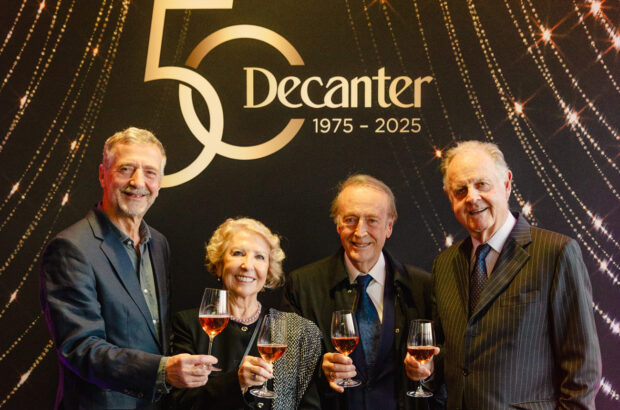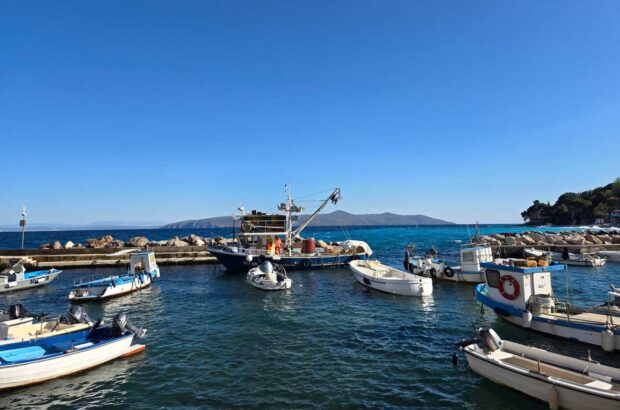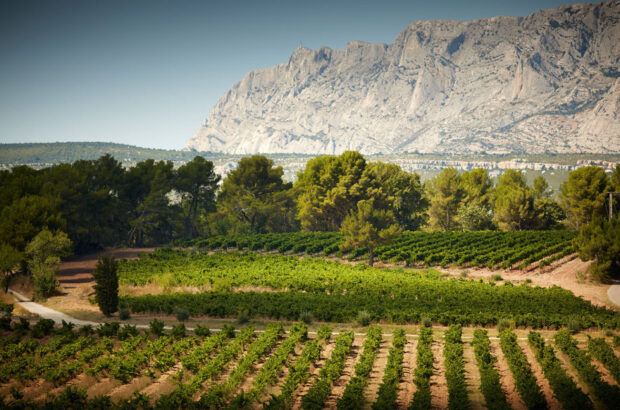Andrew Jefford holds a magnifying glass to Languedoc-Roussillon in France and finds one domain in particular that deserves to be counted among the region's best.
Winemaker Samuel Guibert of Mas de Daumas Gassac, who divides his time between France and California, noted in a recent interview with The Drinks Business magazine that Languedoc needed more ‘train-pullers’, more estates like that of his family. Twenty Gassac-class locomotives, he felt, would be about right to haul the region into the future.
I agree. There’s wonderful small-domain value to be found all over the Languedoc – but such wines can only trickle into export where, like winter streams in spring, they swiftly disappear. For Languedoc to make its mark alongside Bordeaux, the Rhône, Rioja and Tuscany, it needs estates with a bigger reach, selling reference bottles on every significant market, decade after decade.
A vertical tasting I took part in a couple of weeks ago suggested that Prieuré de St Jean de Bébian, close to Pézenas, should now be accorded ‘Languedoc locomotive’ status. (Welcome news, coming just after Axa had sold the nearby Mas Belles Eaux to Grand Chais de France on October 16th, despite having put an enormous amount of work into it in the last decade.)
I remember buying a few bottles of Bébian back in the 1970s from the UK wine merchant Adnams, and reading Simon Loftus’s reports of the capricious eccentricities of owner Alain Roux. Roux did, at least, have the highest ambitions for Bébian at a time when these were uncommon in Languedoc – his Syrah plant material came from Chave, his Grenaches from Rayas and his Mourvèdre from Tempier. The winemaking was fierce and extractive: long macerations, with 100% stems. The unbridled Roux eventually sold up and disappeared; legend has it that he was last seen working as a car-park attendant at Los Angeles airport.
Chantal Lecouty and Jean-Claude Lebrun took over the relay from Roux in 1991. Lebrun had been a part-owner of Revue du Vin de France and Chantal Lecouty had been one of its leading writers and a columnist – so they, too, brought considerable wine culture and continuing ambition to the domain, and the wines grew in finesse. They eventually passed the baton on to Russian steel-pipe magnate Dmitry Pumpyansky and his son Alexander in 2008.
I had a chance to meet Pumpyansky père et fils at the November 19th inauguration of the new cellars at Bébian: a lavish event for Languedoc, with a Fête de la Fleur-style dinner served in the cellar complete with ballet dancers (one aerial, like Tinker Bell) and live duets from West Side Story between the courses, and with the Bébian courtyard transformed into a medieval village. Despite this splendor, the Pumpyanskys seemed engagingly modest about their role, but promisingly committed, too. “In 2008, we started an adventure,” Alexander Pumpyansky told me. “We didn’t know where it was going. We didn’t want to change things too much.” Dmitry had become interested in wine (“because he is interested in everything,” says his son) and they’d looked for a property in Bordeaux – then heard about this sale, and fallen in love with Bébian and its twelfth-century chapel. The new cellar marks their commitment to the property. “It’s a step but we’ll need another ten years.” Well, at least.
They have an asset: Karen Turner, who began making wine at Bébian back in 2004 and who is now ‘the memory’ of the property. (Wine locomotives run on memory fuel.) She’s a widely travelled Australian whose winemaking approach is deeply European, and the quality of wines since 2005 is no small tribute to her remarkable vinification and blending skills.
I’ve been guilty of not taking the wines of the Pézenas area seriously enough in the past, perhaps because this zone doesn’t have the scenic grandeur of some of its Languedoc peers: it’s a set of low hills which interrupts and punctuates the plain rather than the wild, savage, high terraces of the back country. Silly mistake: the proof of terroir is smelled and tasted in the glass, not gauged through the lens of a camera, and wines as variously distinguished as those of Domaine les Aurelles, Clos des Truffiers, Conte de Floris and Domaine Peyre-Rose are produced near here, in addition to Mas Belles Eaux. The dry, gastronomic, attractively packaged and remarkably consistent wines I tasted at Prieuré de St Jean de Bébian (see below) left me convinced that this domain deserves to be counted among Languedoc’s locos, with a range that provides great value at every level, with its whites tasting every bit as enticing as its reds, and with a fine historical record for the red grand vin.
A taste of Bébian
White wines
La Croix de Bébian Blanc 2014
This Pays d’Oc blend of Chardonnay and Viognier is milky, sappy and vinous, with plenty of structure and length; an admirably satisfying mealtime white. 88
La Chapelle de Bébian Blanc 2014
The second white of the estate is based on Grenache Blanc and Roussanne, with a little Clairette. Subtle, teasing notes of freesia and honeysuckle in both the aroma and on the palate, and a plump yet sappy flavour: delicious. 90
Prieuré de St Jean de Bébian Blanc 2014
The blend of this barrel-fermented white is principally Roussanne, with 10 per cent of less of Clairette, Grenache Blanc and Picpoul. Quietly creamy on the nose at present, with incipient palate complexities: pine, wild flowers, almond, stone. 91+
Prieuré de St Jean de Bébian Blanc 2013 (magnum)
A cool, long but fine vintage in the Languedoc. Bread dough, fresh resin and summer hay to smell, with a palate which opens crisply before filling and spreading in the mouth, with juicy yellow and orange fruits napped with cream. 91
Prieuré de St Jean de Bébian Blanc 2011 (magnum)
Very attractive development here: rosemary, honey. Rich, yet fresh and balanced; complex, vibrant, chewy, with more of that refined herbal grace the aromas sketched out. 90
Red wines
La Croix de Bébian Rouge 2014
A clever, relatively pale Pays d’Oc blend of Grenache, Syrah and Cinsault packed full of glycerous charm and seductive cherry and plum fruit. There’s no tannin to speak of, but the fruit has stony complexity nonetheless. Treacherously easy to drink, and would take a light chill well. 87
La Chapelle de Bébian Rouge 2012
A similar blend to the Croix de Bébian using estate AOP fruit, and with Syrah in the driving seat. Imagine a herb-infused Right Bank Merlot plus some of the stony pungency of the Languedoc, and you’ll have the measure of this tasty red. 89
The Grand Vin vertical
Prieuré de St Jean de Bébian Rouge 2013
This vintage has delivered an unusual Prieuré de Bébian with a style more reminiscent of the Northern Rhône than of Languedoc: dark, smoky fruit with less herb notes than usual, and with lots of vibrant concentration on the palate and a bright acid balance. 90
Prieuré de St Jean de Bébian Rouge 2012
Ample and joyful: singing, zesty red fruits with a smooth, translucent central palate and lots of thyme and dry-grass complexity. 89
Prieuré de St Jean de Bébian Rouge 2011
For pure Languedoc style, it’s hard to beat this vintage at the moment: herbal refinement, a stony lift, with very elegant, balanced and settled fruit flavours. A little more glycerous and full than the fresh, juicy 2012. 89
Prieuré de St Jean de Bébian Rouge 2010
Dark, and packed with rich, fleshy fruits. Textured, long and powerful on the palate, with ample yet succulent tannins. Needs more time for maximum Languedoc character to emerge, but this is a hugely promising Bébian which could be aged with confidence. 93
Prieuré de St Jean de Bébian Rouge 2009
Less primary than the 2010 at this stage but this velvety, warm wine has even more grandiose tannins, and it’s in those voluminous, comforting textures that the complexity of the wine becomes apparent. 92
Prieuré de St Jean de Bébian Rouge 2008
Like 2013, this is very much a fruit-first vintage: well-preserved, poised and lifted, with notes of the box plants which grow wild in the garrigue alongside the herbs, but tannin-supported, too. Admirable drinking just now, but no hurry to finish. 91
Prieuré de St Jean de Bébian Rouge 2007
A warm vintage, and for me the most ‘New Worldly’ of the set: thick, rich and just a little sweet, but delicious tobacco-leaf complexities too. 89
Prieuré de St Jean de Bébian Rouge 2006
The first wine in the set showing comprehensive maturity, with splendid aromatic complexity: underbrush, dry leaves, dry grasses, sweet herbs and warm stones. On the palate, this is firm, chunky and solidly constituted; its splendidly resonant tannins look set to see out another decade. 93
Prieuré de St Jean de Bébian Rouge 2005
Another attractively mature wine, this time with a kind of Pessac-Légnan-like finesse to it: graceful and intricate, grainy and open, with the tannins forming a soft net around the warm, glowing fruits. 91
Prieuré de St Jean de Bébian Rouge 2004
2004 takes the ageing cycle just a little further, but this was obviously a well-constituted wine to start with, with thickly layered plum, tobacco and thyme flavours, generous tannins and a fleshy, visceral appeal. Gorgeous now. 92
Prieuré de St Jean de Bébian Rouge 2001
A grand classic, and an even better bottle than the already impressive example of the 01 Bébian I tasted in May this year, this is still a dark and youthful-looking wine with impressive earth, pine and thyme complexities, a fresh, elegant mid-palate, and a finish packed with liquorice and other root spices. 93
More Jefford on Monday columns:

Jefford on Monday: Grange meets La Niña

Jefford on Monday: A chat with Philippe

Jefford on Monday: Change is coming

Jefford on Monday: Old Dominion Classics







